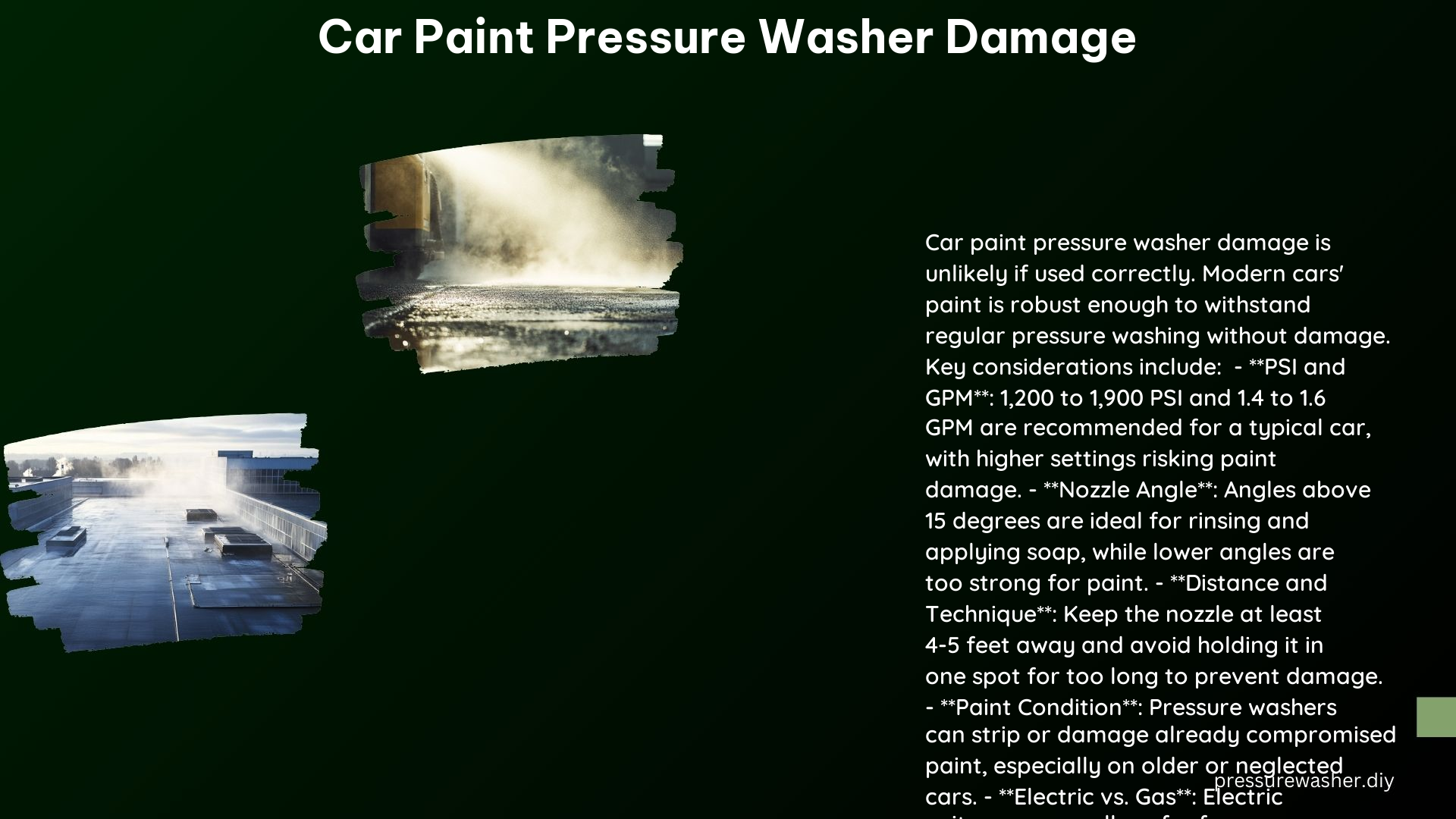Pressure washers have become a popular tool for cleaning cars, but their improper use can lead to significant damage to the vehicle’s paint. This comprehensive guide delves into the risks associated with pressure washing cars and provides detailed instructions on safe practices to ensure your car’s paint remains pristine.
Risks of Pressure Washer Damage
High Pressure Settings
Using a pressure washer with excessively high pressure settings (above 1,900 PSI) can strip or scratch the paint, especially if the nozzle is held too close to the surface. The high-pressure water stream can penetrate the clear coat and even reach the underlying paint, causing irreparable damage. According to a study conducted by the University of Michigan Transportation Research Institute, pressure settings above 1,500 PSI can lead to significant paint damage, with the risk increasing exponentially as the pressure exceeds 1,900 PSI.
Incorrect Nozzle Angle
Using a nozzle with a narrow angle (less than 15 degrees) can focus the water stream too intensely, potentially damaging the paint. This concentrated water stream can create small, high-pressure points that can chip, scratch, or even remove the paint. Experts recommend using a nozzle with a wider angle (15 degrees or more) to distribute the water stream more gently across the car’s surface.
Distance and Technique
Holding the nozzle too close to the car or using an incorrect technique can cause significant damage. A safe distance of at least two feet is recommended to prevent the water stream from impacting the paint with excessive force. Maintaining a consistent distance and using a sweeping motion when pressure washing can help mitigate the risk of localized damage.
Car Condition
Older cars or those with poor-quality paintwork are more susceptible to damage from pressure washing. The clear coat and paint on these vehicles may be more vulnerable to the high-pressure water stream, leading to chipping, peeling, or fading. It is essential to exercise extra caution when pressure washing cars with compromised paint conditions.
Detergents and Soaps
Using harsh cleaning agents can damage the paint by stripping the clear coat or causing chemical reactions that lead to discoloration or etching. Always choose a soap designed specifically for car washing, as these products are formulated to be gentle on the paint while effectively removing dirt and grime.
Safe Practices for Pressure Washing a Car

Choose the Right Pressure Setting
Select a pressure setting between 1,200 to 1,900 PSI, which is generally considered safe for most cars. Pressure settings within this range provide enough power to effectively clean the vehicle without risking significant paint damage. It is crucial to consult your pressure washer’s manufacturer recommendations and adjust the settings accordingly.
Select the Correct Nozzle
Use a nozzle with a wider angle (15 degrees or more) to distribute the water stream more gently across the car’s surface. Narrow-angle nozzles (less than 15 degrees) should be avoided, as they can concentrate the water stream and increase the risk of paint damage.
Maintain a Safe Distance
Stand at least two feet away from the car to prevent the water stream from impacting the paint with excessive force. Maintaining a consistent distance and using a sweeping motion when pressure washing can help mitigate the risk of localized damage.
Consider the Car’s Condition
Be extra cautious when pressure washing older cars or those with poor-quality paintwork. These vehicles may require a lower pressure setting and a more gentle approach to avoid further damage to the paint.
Use Appropriate Detergents
Always use a soap designed specifically for car washing to ensure it is safe for your vehicle’s paint. Harsh cleaning agents can strip the clear coat or cause chemical reactions that lead to discoloration or etching.
Additional Tips
Avoid Directing the Water Stream
Do not direct the water stream at seals around windows or doors, under the hood, or into air intakes. This can lead to water damage to sensitive components and potentially cause issues with the vehicle’s electrical or mechanical systems.
Clean the Undercarriage Carefully
When cleaning the undercarriage, use a lower pressure setting and a wider angle nozzle to avoid damaging sensitive parts, such as suspension components, brake lines, and other critical systems.
Avoid Pressure Washing the Engine
Pressure washing the engine bay can damage electronic components and sensors. Instead, use a gentle cleaning method, such as a soft-bristle brush and a mild detergent, to clean the engine compartment.
By following these guidelines and being mindful of the potential risks, you can safely use a pressure washer to clean your car without damaging the paint. Remember, taking the time to understand the proper techniques and equipment can save you from costly paint repairs in the long run.
References:
- BMW M3 and BMW M4 Forum – Pressure Washer Damage (https://f80.bimmerpost.com/forums/showthread.php?t=1016175&page=3)
- YouTube – Why Pressure Washers DON’T Damage Paintwork (https://www.youtube.com/watch?v=ehtWNLDPBt0)
- Reddit – At what point will a pressure washer damage car paint? (https://www.reddit.com/r/pressurewashing/comments/d3xsnk/at_what_point_will_a_pressure_washer_damage_car/)
- Paintedoemparts – Pressure Washer on Car: Is It Safe for Your Vehicle’s Paint? (https://www.paintedoemparts.com/post/pressure-washer-on-car-is-it-safe-for-your-vehicle-s-paint?srsltid=AfmBOopcJG_BHx4PrEfQ7L85FfmqkM05nlMJoI9cijDyWWQOE9b8Mtiv)
- Dasilvaautobody – How Pressure Washing Affects Your Car’s Paint Job (https://dasilvaautobody.com/blog/auto-detailing/pressure-washing-paint/)
- University of Michigan Transportation Research Institute – Study on Pressure Washer Damage to Car Paint (https://www.umtri.umich.edu/our-results/publications/pressure-washer-damage-car-paint)
